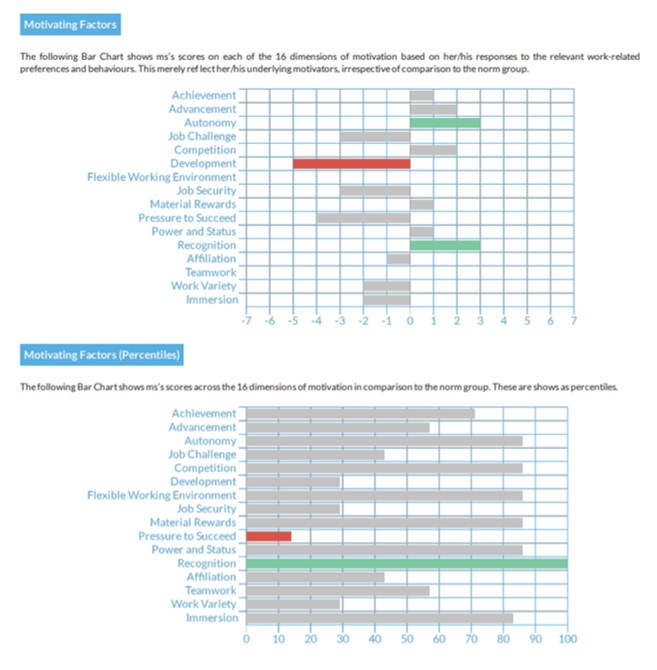Employee Psychometric assessment
MOHR has two categories of employee assessment:
- Psychometric assessments.
- Cognitive abilities assessments.
Psychometric assessments :
MOHR has a set of psychometric assessments that help in deep understanding of your employees. These tests can be used for:
- Assessing job candidates, so that you can choose the best fit for the job.
- Assessing your employees to find out skill gaps and competencies gap
- Assessing your employees to find out your potential future leaders and managers.
Moreover, anyone -either an employee or not even employed, manager or entrepreneur- can take these assessments to get deeper understand of his personality traits, strengths, weaknesses, and areas of development.
Psychometric assessments:
PersonalityPlus test:
PersonalityPlus is an effective assessment tool
that describes the personality traits and the
behavioral tendencies of the candidate.
The assessment is designed to capture and measure 32
personality traits
PersonalityPlus
is to be used for a broad range of
human resources management applications,
which include self-awareness, teambuilding,
performance management, change
management, coaching, and employee development.

Occupational Competency Model (OCM)

Occupational Competency Measurement (OCM)
assessment identifies the candidate’s tendency to
demonstrate the relevant competencies and work‐related
behaviors critical for the job. t assesses the candidate’s
knowledge of the measured competencies as well as her/his
tendency to possess the critical and relevant skills.
The OCM Model reports on 12 competency clusters,
measuring 24 individual competencies. It captures
4 main competency domains representing 4 broad areas
of competence; namely: Cognitive; Management and Leadership;
Execution; and Interpersonal. Each of these domains consists of
clusters, reflecting the groups of competencies
which are similar in terms of the skills and behavioral
abilities needed to demonstrate them effectively.
ASSESS OCM is a general-purpose computer-based ipsative assessment questionnaire that takes 35-40 minutes to complete. It can be incorporated in various solutions, including mass and executive recruitment, talent development and succession planning. Download Sample Report (En). | Download Sample Report (Ar).
Career Orientation :
Career Orientation helps you identify the careers most suitable for your personality type, based on a set of questions covering your interests, motives, skills, values, and preferences. The model used is based on Holland six personality types: Realistic, Investigative, Artistic, Social, Enterprising, Conventional.
This report on career orientation gives you a deeper understanding of yourself and guides you in deciding on the career path you ought to pursue.
Career orientation options are determined by pairing of types, so for example an investigative realistic type may be advised to work in engineering or technical jobs, whereas an investigative artistic type may flourish in psychology, anthropology, political science, or video editing.
Motivation :
Motivation is an assessment that helps in pinpointing and identifying the candidate’s motivators across 4 major clusters of factors, namely: Physiological; Relatedness; Growth; and Work Dynamics-related factors. The candidate is assessed on 15 sub-dimensions to identify the factors that contribute most and least to her/his motivation to work and perform, as well as those factors that reduce her/his motivation to work. This assessment, therefore, provides in-depth insights to the candidate’s underlying motivations; thus, helping in matching the right candidate to the right job and culture (hence, person-job fit and person-organization fit). Furthermore, it provides valuable information that would guide an effective process of compensation and provision of incentives.
Motivation Questionnaire report provides a detailed description of the candidate’s critical motivating, non-motivating, and demotivating factors. The report clarifies, on a broader level, whether the candidate is intrinsically or extrinsically motivated; and, on a narrower level, which of the measured factors contribute the most and the least to, or have no effect, or have negative effect on her/his motivation. The 15 sub-dimensions across which the candidate is assessed are as follows: Material Rewards and Job Security as Basic/Physiological aspects; Teamwork and Affiliation as Social Affection Relatedness factors; Power & Status and Recognition as Self-Esteem Relatedness factors; Achievement, Autonomy, Advancement, Development, and Pressure to Succeed as Growth Factors; and Flexibility, Variety, Competition, and Job Challenge as Work Dynamics-related factors.
Download Sample Report (En). | Download Sample Report (Ar).

Personality Basic :
Personality Basic is an assessment that is inspired from Myers Briggs Type Indicator (MBTI). The assessment consists of set of questions/statements which tackle various personality preferences and behaviors that accordingly measure underlying personality dimensions. The assessment determines the candidate’s personality out of 16 personality types.
The Personality Basic assessment provides a personality profiling report with a detailed description of the assessee’s characteristics including personality and behavioral tendencies, how she/he is likely to contribute to the organization, and her/his leadership, learning, and problem-solving styles. It also gives the recruiter an overall picture of the candidate’s potential pitfalls and areas that she/he may need to develop; as well as the nature of the working environment, structures, systems, and procedures in which the candidate is likely to be most productive at.
Leadership Styles :
ASSESS Leadership Style assessment identifies the strong and weak leadership styles in each candidate by measuring 6 critical workplace leadership traits. The traits are:
- Affiliate
- Coaching
- Commanding
- Democratic
- Pacesetting
- Visionary
Potentiality :
Potentiality assessment provides a tool for HR practitioners to identify and pinpoint caliber who can be future leaders and hold higher level positions; hence ‘who have the potential’. This report also measures the potential of being a successful entrepreneur. This report can, thus, be used to draw a profile about the assessment taker, as well as to identify her/his areas of strengths and development with regards to her/his potentiality as a high caliber or a leader or even an entrepreneur. The assessment measures and helps to report on 6 main dimensions that have been identified as critical to an individual's potentiality; namely:
- Drivers
- Personality Profile fit
- Self-awareness
- Growth mindset
- Agility
- Business Acumen